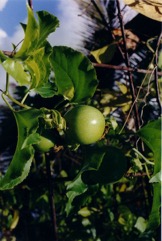Yellow passionfruit

A tropical plant. It grows in the tropical lowlands. It benefits from sun except under very hot conditions (>38°C). Plants need good drainage and adequate water. They are very susceptible to frosts. They need temperatures above 12°C. It is like purple passionfruit but will grow in warmer locations. They commonly grow between sea level and 800 m in the tropics.
Also known as:
Goki dimputu, Golden passion fruit, Guavadilla, Karora chi, Lilikoi, Maracuya amarillo, Maracuja peroba, Saptheilempa
Edible Portion
- Fruit
Where does Yellow passionfruit grow?
Found in: Africa, Amazon, Australia, Brazil, Central Africa, Central America, Congo DR, Costa Rica, Guiana, Guianas, Guyana, Hawaii, India, Mexico, Northeastern India, Pacific, Papua New Guinea, PNG, South Africa, Southern Africa, South America, Suriname, United States, Vanuatu, Venezuela
Notes: There are about 400 Passiflora species. It can become self sown and a problem in some Pacific Islands regions. Fruit are high in folates 271μg/100.
Growing Yellow passionfruit
Cultivation: Plants are commonly grown from seed. They can be grown from cuttings. The vine needs to be pruned regularly. This reduces less vigorous growth and promotes flowering. Bottom heating the seeds at 20-26°C can result in germination at 1-2 weeks, at lower temperatures seeds can take up to 10 weeks to germinate.
Edible Uses: The pulp of the fruit is eaten fresh. The seeds are edible. The fruit are used to flavour food and drinks.
Production: Flowering can continue year round under suitable conditions. Individual flowers bloom for 12-24 hours. Flowers need to be hand pollinated or pollinated by bees. They will not self pollinate. Fruit ripen from flowering in 80 days. Plants continue their productive life for 4-6 years. Fruit are harvested when they fall. Fruit are considered fully ripe and ready for eating when the skin starts to wrinkle.
Nutrition Info
per 100g edible portion| Edible Part | Energy (kcal) | Protein (g) | Iron (mg) | Vitamin A (ug) | Vitamin c (mg) | Zinc (mg) | % Water |
|---|---|---|---|---|---|---|---|
| - | - | - | - | - | - |
Yellow passionfruit Photos

References
Bourke, R. M., Altitudinal limits of 230 economic crop species in Papua New Guinea. Terra australis 32.
Chin, H.F., & Yong, H.S., 1996, Malaysian Fruits in Colour. Tropical press, Kuala Lumpur p 39
Cull, B.W., 1995, Fruit Growing in Warm Climates. Reed. p 141
Cundall, P., (ed.), 2004, Gardening Australia: flora: the gardener's bible. ABC Books. p 991
Darley, J.J., 1993, Know and Enjoy Tropical Fruit. P & S Publishers. p 96
Facciola, S., 1998, Cornucopia 2: a Source Book of Edible Plants. Kampong Publications, p 166
Fl. Haw. Fam. 250. 1946
Latham, P., 2004, Useful Plants of Bas-Congo province. Salvation Army & DFID p 213
Lyle, S., 2006, Discovering fruit and nuts. Land Links. p 312
Martin, F. W., et al, 1987, Perennial Edible Fruits of the Tropics. USDA Handbook 642 p 50
Medhi, P. & Borthakur, S. K., 2012, Phytoresources from North Cachur Hills of Assam -3: Edible plants sold at Hflong market. Indian Journal or Natural Products and Resources. 3(1) pp 84-109
Medhi, P. & Borthakur, S. K., 2013, Wild edible plants sold by the Zeme Nagas at the makeshift market of Mahur, Dima Hasao district of Assam. Pleione 7(1): 84 - 93. 2013
Segura, S., et al, 2018, The edible fruit species in Mexico. Genet Resour Crop Evol (2018) 65:1767–1793
Omawale, 1973, Guyana's edible plants. Guyana University, Georgetown p 33
Paz, F. S., et al, 2021, Edible Fruit Plant Species in the Amazon Forest Rely Mostly on Bees and Beetles as Pollinators. Journal of Economic Entomology, XX(XX), 2021, 1–13
PROSEA (Plant Resources of South East Asia) handbook, Volume 2, 1991, Edible fruits and nut. p 244
Recher, P, 2001, Fruit Spirit Botanical Gardens Plant Index. www.nrg.com.au/~recher/ seedlist.html p 3
Sharma, B.B., 2005, Growing fruits and vegetables. Publications Division. Ministry of Information and broadcasting. India. p 104
Staples, G.W. and Herbst, D.R., 2005, A tropical Garden Flora. Bishop Museum Press, Honolulu, Hawaii. p 450
Striegel, L., et al, 2019, Promising Tropical Fruits High in Folates. Foods 2019, 8, 363; doi:10.3390/foods8090363. www.mdpi.com/journal/foods
USDA, ARS, National Genetic Resources Program. Germplasm Resources Information Network - (GRIN). [Online Database] National Germplasm Resources Laboratory, Beltsville, Maryland. Available: www.ars-grin.gov/cgi-bin/npgs/html/econ.pl (10 April 2000)
van Wyk, B., 2005, Food Plants of the World. An illustrated guide. Timber press. p 279
van Wyk, Be., & Gericke, N., 2007, People's plants. A Guide to Useful Plants of Southern Africa. Briza. p 52
Walter, A. & Lebot, V., 2007, Gardens of Oceania. ACIAR Monograph No. 122. p 209
Zuchowski W., 2007, Tropical Plants of Costa Rica. A Zona Tropical Publication, Comstock Publishing. p 189